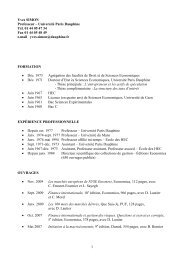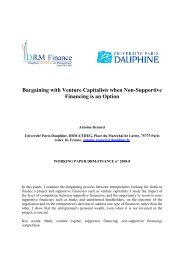Corporate governance and earnings management ... - CEREG
Corporate governance and earnings management ... - CEREG
Corporate governance and earnings management ... - CEREG
You also want an ePaper? Increase the reach of your titles
YUMPU automatically turns print PDFs into web optimized ePapers that Google loves.
goodwill in the balance sheet at (unamortized) cost also shows that even the weakened<br />
static solution was not considered satisfactory by a certain number of businesses, <strong>and</strong><br />
presumably that treating goodwill as an unamortizable asset was approved by certain<br />
auditors.<br />
In our opinion, the weakened static solution is effectively a “convenient” variant of the<br />
purely static approach. Its aim is not to make goodwill an asset, but to make it disappear<br />
“softly, softly”. Our view appears to correspond to the position currently defended in Great<br />
Britain. Holgate (1990, p. 11) for example, describes how two schools of thought emerged at<br />
a discussion by the ASC in 1980 on the treatment of goodwill. One school considered that<br />
“goodwill was not like other assets in that it could not be separately realized..., was of no<br />
value … <strong>and</strong> should be written off directly against reserves…” The other school believed<br />
“that goodwill was an asset … (on a going concern basis)”. What clearer indication could we<br />
wish for that writing off against equity remained a static-type approach!<br />
During all that period pooling (or merger accounting) was possible under some conditions<br />
but rarely practiced (Paterson, 2001, p. 98).<br />
3.2.2. USA: the “weakened” static phase (1900 - 1970)<br />
As in Great Britain, the static approach still dominated in the United States during this<br />
period, the basic view being that goodwill was not a real asset <strong>and</strong> should be made to<br />
disappear as soon as possible. This observation which we will support below, is corroborated<br />
by one contemporary opponent’s regrets: “current doctrine for the most part holds that, even<br />
purchased, goodwill should be written as soon as possible” (Anonymous, 1913, p. 817).<br />
However, rather than being charged to expenses, goodwill was increasingly charged against<br />
equity, <strong>and</strong> so the “weakened static approach” began to predominate as it did in Engl<strong>and</strong>.<br />
In theoretical terms, Dicksee’s ideas were widely echoed in the United States, where many<br />
authors favored the solution of an immediate write-off against <strong>earnings</strong> or capital surplus<br />
(Kester, 1922, p. 419; Lincoln, 1923; Mac Kinsey & Meech, 1923, p. 538).<br />
29



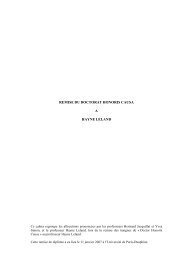

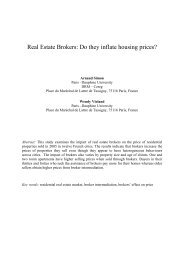
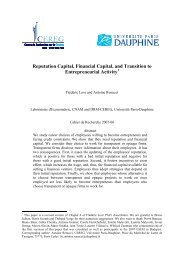

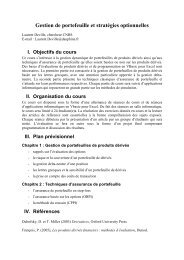


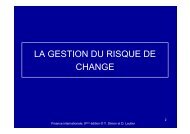
![& 6 ] ^ F ]^ - CEREG - Université Paris-Dauphine](https://img.yumpu.com/33326502/1/184x260/-6-f-cereg-universitac-paris-dauphine.jpg?quality=85)

